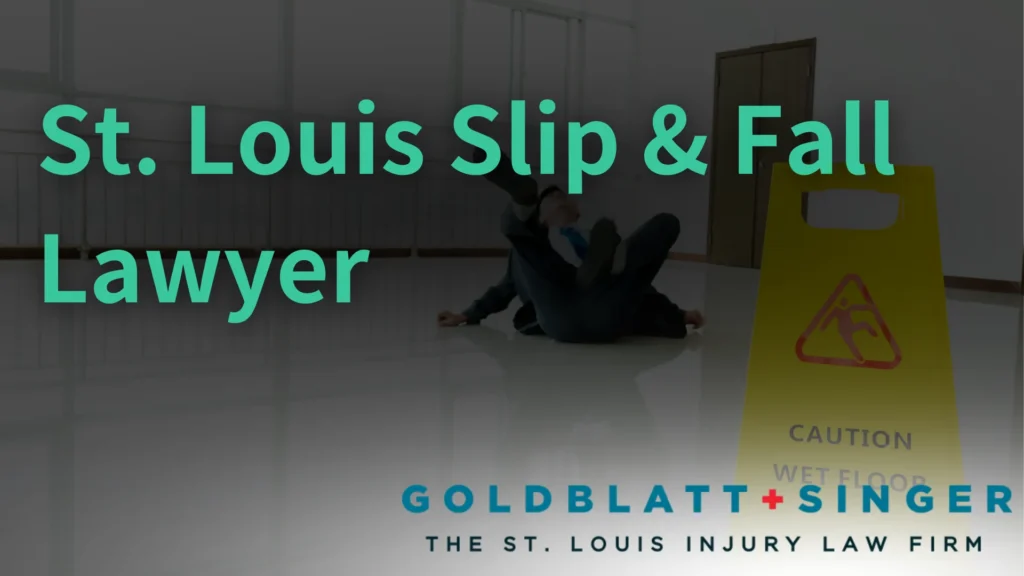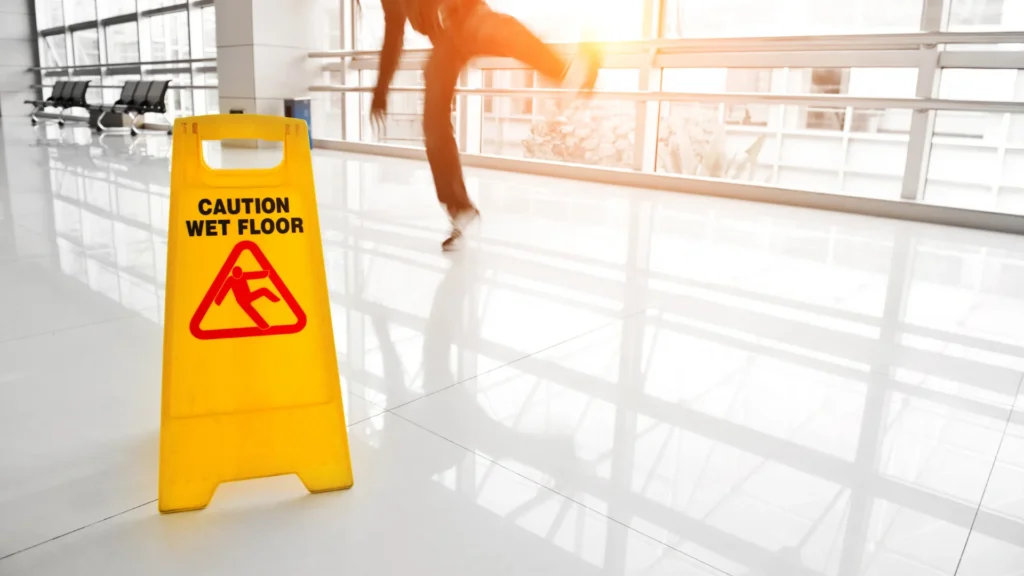
Did you suffer a broken bone, sprain, head injury or other harm after a slip/trip and fall accident in St. Louis? Talk to a slip and fall attorney about your case at Goldblatt + Singer. Slip, trip, and fall accidents are some of the most common causes of unintentional injuries in the country. According to the National Floor Safety Institute, falls account for more than 8 million trips to the emergency room each year. Nearly one million of these incidents stem from slips and falls alone. If you or a loved one suffered any kind of injury in a bad fall in St. Louis, contact our fall accident lawyers for assistance.
Slip, trip, and fall accidents take the form of premises liability claims in Missouri. The law holds property owners legally responsible for the safety of their premises, including finding and remedying potential slip or trip hazards. Property owners owe certain duties of care to all who enter the land – even to trespassers if they are under the age of 18 in Missouri. An owner’s duties of care vary according to the status of the visitor. Three main types of visitors exist:
To have a premises liability claim against a landowner, company, or another party in Missouri after a slip and fall or trip and fall, you must first identify your status as a visitor. Then, you must analyze whether the property owner in charge of maintaining the premises fulfilled his or her duties to you according to your classification. If not, you likely have grounds to file a fall-related personal injury claim against the owner. The legal team at Goldblatt + Singer can help you with every element of your claim from beginning to end.
Falls are a leading cause of severe injuries and fatalities. When victims survive, they must often live with life-changing repercussions. Common injuries include:
Traumatic brain injuries (TBIs) are most often caused by falls. They can range from mild to severe, but victims may be left with permanent impairments.
The impact of a fall can jolt the shoulder, often leading to dislocations or brachial plexus injury, which can cause pain, weakness, and numbness in the arm and hand.
Muscle strains and sprains, compression fractures, herniated discs, tailbone injuries, and spinal cord injuries (SCIs) are common in slip and fall accidents. If a victim suffers a serious SCI, they may experience varying degrees of paralysis and loss of sensation below the level of damage.
Severe bone fractures often affect the wrists, ankles, and especially the hips.
Over 95 percent of broken hips are caused by falls, according to the CDC. The elderly are at particular risk of this type of injury.
Sprains and strains in the soft tissue of the legs, ankles, arms, hands, or wrists are very common.
The party liable in a St. Louis slip and fall claim will depend on where your accident occurred. Slip and fall accident cases fall under premises liability laws. These laws hold property owners accountable for ensuring visitors are reasonably safe. For example, under premises liability law, many owners must:
When a property owner or manager fails in their duty, they can be held accountable for resulting injuries. Some examples of potential parties include the following:
Business owners owe visitors a higher duty of care. They are responsible for regularly inspecting the premises for hazards, and as soon as they are made aware of a potential risk, it must be corrected or warned of as quickly as possible. Therefore, if a slip and fall were to occur due to their negligence in maintaining the premises, the business’s owner would be liable for your slip and fall.
Private property owners owe a lower duty of care to keep visitors reasonably safe. Since their property is for non-business purposes, property owners do not have to regularly inspect for hazards but must fix identified dangers within a reasonable amount of time or warn visitors of them. If a private property owner is aware of a hazard or should have been knowledgeable and failed to fix it within a reasonable amount of time or alert you, they would be liable for a slip and fall.
A government agency may be liable if you have a slip and fall caused by a dangerous condition on government property. To pursue a case against a government agency or employee in Missouri, you must first file a claim with the Office of Administration’s Risk Management Division within 90 days of the injury. The government will then review your notice of claim and determine whether to pay it.
Many slip and fall accidents happen while at work. When a worker is injured on the job, they are entitled to workers’ compensation benefits. However, sometimes a third party is also liable. In these cases, you can pursue a slip and fall claim against the third party in addition to your workers’ comp claim.
To hold a property owner liable after a slip and fall accident, you must prove their negligence was the cause. Demonstrating a property owner’s negligence can be challenging as it requires evidence that a dangerous condition existed, and either the owner knew or should have known about it and failed to fix it. You must also be able to establish the following four elements of negligence:
The property owner owed you a duty of care to keep their premises safe. For the property owner to owe you a duty of care, you must have been permitted to be on the property. For example, an invited guest, a customer at a retail store, etc. Trespassers are not owed any duty of care except in very limited circumstances.
The property owner failed to keep their premises reasonably safe for visitors. They either knew or should have known that a dangerous condition existed for a sufficient period of time before the accident occurred.
The owner’s failure to reasonably maintain the premises contributed to your slip and fall accident. There must be a clear link between the property hazard and your slip and fall accident. In other words, you would not have been injured if the property owner had fixed or warned you of the danger. The court will examine whether the owner acted as a reasonably prudent person would have when in the same circumstances. To do so, factors such as the following will be considered:
To shift liability, a property owner or their insurance carrier will likely argue that you share or are entirely at fault for the slip and fall.
Proof you sustained damages (losses) due to your slip and fall accident. For example, medical bills, lost income, emotional distress, mental anguish, pain and suffering, etc.
After a slip and fall accident in St. Louis, MO, victims may be able to recover the following types of compensation:
That includes emergency transportation and care, hospitalizations, surgeries, doctor visits, prescription medications, physical and rehabilitative therapy, in-home care, and any other injury-related medical care expenses, including anticipated future treatment.
You have the right to recover your current lost wages and the income you are likely to lose in the future while recovering. In addition, if you cannot earn the same income or must go into a different line of work because of your injury, you may also be able to obtain compensation for diminished earning capacity.
Reimbursement for the repair or replacement of any items that were damaged in your fall accident. For example, your phone, jewelry, clothing, purse, backpack, laptop, etc.
Compensation for physical pain and/or emotional distress (e.g., loss of enjoyment of life, depression, anxiety, etc.). Since these losses are not calculable, different factors are considered to estimate their worth. For instance, the severity of your injuries, their impact on your life, your age, your age, and health before the accident, any pre-existing injuries, the degree of the property owner’s negligence, and more.
Negligent property maintenance is a common cause of slip and fall injuries in St. Louis. Claims commonly arise from:
A brief fall can be all that is needed to cause a traumatic brain injury, break a bone, or damage the spine.

Anyone who owns property in Missouri has an obligation to keep visitors safe. However, the degree to which they must protect guests from harm depends on the person’s status. Missouri law divides visitors into three main classifications:
Although property owners do not owe trespassers a duty of care, they can be held liable for an injury to a trespassing child. Under the state’s law of attractive nuisance, property owners must take adequate safety measures to decrease the risk of a child wandering onto their property and getting hurt. For example, installing a fence or gate around a swimming pool.
Unfortunately for actual victims of slip, trip, and fall accidents, thousands of fraudulent insurance claims over the years have made these cases somewhat difficult to prove. It’s important to hire an attorney to maximize your odds of success, especially if going up against a major company’s insurer, such as Walmart or Lowe’s. Large corporations have plenty of money and resources to throw at personal injury lawsuits, often resulting in accident victims agreeing to smaller settlements than they should.
To prove your slip, trip and fall claim, you will need to collect evidence that the property owner owed you a duty of care, neglected to fulfill this duty and thereby caused your accident and related injuries. Prepare for the property owner to try to allege your shared fault for the accident. For instance, the defendant might try to lower his/her liability for the incident by stating that you weren’t watching where you were going. It takes an experienced trip and fall lawyer to combat this common defense and maximize compensation despite Missouri’s shared fault laws. To work with our slip and fall attorneys in St. Louis, contact Goldblatt + Singer today.
“I was hurt in a car accident, and my attorney Christopher S. Saracino, Jr. and Courtney Mayer worked tirelessly to make sure I got all the help I needed to help with my recovery…
Goldblatt + Singer Law Firm TRULY CARES about their clients! They keep you informed about what is going on every step of the way. If you have any questions, they call you back right away (Even after regular working hours). GOLDBLATT + SINGER IS THE BEST LAW FIRM TO CHOOSE if you’re involved in an accident. I HIGHLY RECOMMEND this law firm!”
“I had a horrible accident and I knew my hospital bills were going to be ridiculously high and I had no idea what to do…
A friend referred me to this company and from the beginning they made me feel like I had someone on my side. They didn’t only call about my case, but to check on me and see how I was feeling. The experience I had with them was amazing and I would refer everyone to let them assist you with your problem!”
“Passing through the St. Louis area, I suffered a bad injury at a local business…
I called Amanda at Goldblatt + Singer to talk through what happened. Amanda and her team took my case and made sure I was taken care of from beginning to end.”
“Thank you for all you’ve done in helping me recover! I wanted you to know how much you are appreciated…you’ve been such a great help to me in many areas. God bless you for your services as a great attorney.”